Abstract
This experiment was conducted in the pine woods of central Europe at a research area established in 1951. The experimental area of 1.35 ha was set up in a 14-year-old pine tree stand, which was divided into lots, and the pruning procedure took place in different variants. Some lots constituted control lots without pruned trees. The trees were pruned in four variants, reducing the living tree crown by 1/4, 1/3, 1/2, and 2/3 of its length. The study’s main aim was to determine the influence of pruning forest trees on the tree tissue. Moreover, the study attempted to answer whether pruning was a significant procedure for wood valorisation, and if yes, then which variant was the optimal one for Scots pine growing on the European plain. The results indicated a significant impact of pruning young pine tree stands on the properties of wood tissue, which differed regarding the adopted pruning variant. Significant differences in the width of annual rings, the size of the particular areas of the annual rings (latewood or earlywood), and the wood density depending on the pruning variant were observed. Furthermore, the results indicated that pruning induced numerous processes, which optimised the physiological and mechanical functions of the tree trunks. The outcome of this optimisation was, among others, the diversification of the vascular and strengthening area of the annual ring as well as the wood density, which was a reaction to reducing a part of the assimilation apparatus. From the technical wood value viewpoint, the optimal pruning variant for pine was between 1/3 to 1/2 of the living crown.
1. Introduction
Economic benefits derived from any product, including wood, depending on quantity and quality. The factors influencing wood production efficiency and wood quality are manifold. Growth conditions and forest management are the most decisive factors impacting wood production [1,2]. While environmental growth conditions such as climate or soil properties cannot be easily changed, the formation process of wood can be modified by forest management, which can considerably change tree dimensions, mortality, wood quality, and value [3,4]. In addition to thinning, crown pruning is the most widely used management option to increase wood quality. Crown pruning has a long history in forest management worldwide, in particular for widely spaced stands and species with limited ability to shed dead branches (self-pruning) and a tendency to develop knotty timber, such as is observed in many conifers [5,6]. Pruning can increase the share of knot-free timber but requires capital investment and may adversely affect tree growth [7,8,9,10].
Various genetic and environmental factors influence wood density, vessel dimensions, ring width, and other wood properties. For coniferous trees, the effects of silvicultural treatment on wood quality have been studied by focusing primarily on thinning, whereas the influence of pruning itself still needs to be fully understood [11]. There is evidence that live-branch pruning enhances wood quality by increasing the share of knot-free timber [12,13]. Pruning can result in lower tree growth compared to unpruned reference stands, presumably as a reduced leaf area results in lower levels of photosynthesis [14]. Recent studies on several conifer species suggest a mild positive effect of pruning on wood properties. Pruning, especially if combined with thinning, results in a larger tree volume, higher tree diameters, and more knot-free timber [11,15,16]. The pruning of young pine stands has been reported to increase the basic wood density by up to 7% [17,18], which could result in a higher bending strength and stiffness. Other studies showed that pruning and thinning had small to no significant effects on wood density and tracheid length [19,20]. In summary, the quality of wood results from various, partly poorly understood, factors.
The effects of management and stand treatment on a tree’s physiological processes and the consequences of commonly applied procedures are widely discussed in the literature [2,14]. Pruning reduces the photosynthetically active parts of a tree and, in consequence, modifies the tree’s productivity [12]. As previously mentioned, the main adverse effect of pruning is tree growth reductions in terms of height and diameter. However, several studies have shown that the impact of pruning on growth is small and temporary. For instance, for Pinus radiata, removing 20%–35% of the live crown resulted in height increment reduction lasting for no longer than one year [21]. In Pinus taeda stands, removing even 50% of the live crown did not reduce the tree height significantly [13]. Removing the middle and lower parts of the tree crown may even exert positive effects (more tree growth), as suppressed branches due to self-shading do not contribute much to overall tree growth, and their respiration demand may exceed the photosynthetic production, as shown for Pseudotsuga menziessii [19].
Forest management, including pruning, affects tree morphology. Pruned trees become more cylindrical and have a larger taper. However, this effect has been reported to be transient, lasting only a few years for Pinus pinaster and Pinus radiata [22]. In Pinus radiata stands, pruning combined with thinning increased the taper index and negatively affected the internode length of new growth units, while the number of newly formed branches increased. While severe pruning (60%–75% of the tree height) reduces the diameter increment, retaining at least 55% of the living crown has been recommended to balance the positive and negative effects of pruning [22]. There is some evidence that social status and vitality modifies the impact of pruning, as for subdominant trees the reduction in diameter increment by pruning was greater than that for dominant trees [23]. Pruning in Pinus radiata can cause trees to lose their dominance if more than 40% of the live crown is removed, while retaining 25%–50% of the crown ensures that pruned dominant trees remain dominant [21].
Pinus sylvestris is one of the most widespread and economically important species in Europe and Asia [24,25,26]. The available literature on pruning effects on Pinus sylvestris is scarce [27,28]. This study provides insight into pruning effects on Pinus sylvestris growing in central Europe, including the positive (i.e., an improvement in wood quality) and negative (i.e., growth reduction) effects of crown pruning using a triple-replicated experiment with five pruning intensities.
2. Material and Methods
The study site was in the experimental research forests of the Faculty of Forestry of the University of Life Sciences in Poznań (52°51′16.9″ N, 17°02′55.0″ E) (Appendix A; Figure A1, Figure A2 and Figure A3; Table A1, Table A2 and Table A3). The experiment was established in 1951 in a 15-year-old Pinus sylvestris stand originating from artificial regeneration. In 2019, the stand was 83 years old, and the experiment had been ongoing for 68 years. The stand is growing in a humid coniferous forest habitat, its stocking index is very high, amounting to 1.0, and the growing stock is 390 m3/ha (Table 1).

Table 1.
Summary of stand structure in the five pruning variants in an eighty-three-year-old Pinus sylvestris stand.
In 1951, the 15-year-old stand was divided into 15 equal parcels with dimensions of 30 × 30 m, and the total area of the stand was 1.35 ha (Figure 1). The parcels marked with the letter “A” were left as unpruned references. On the parcels labelled “B”, pruning of 1/4 of the living crown was conducted. On the parcels labelled “C”, 1/3 of the live crown was pruned, while on the parcels labelled “D”, 1/2 of the crown was removed, and on the parcels labelled “E”, 2/3 was removed (Figure 1). For fifty-three years, three pruning treatments with the same intensity were conducted in each parcel following the initial treatment depending on letter A–E. The removal of dead and dying trees was conducted three times, the first in 1966, the second in 1980, and the third in 1996.
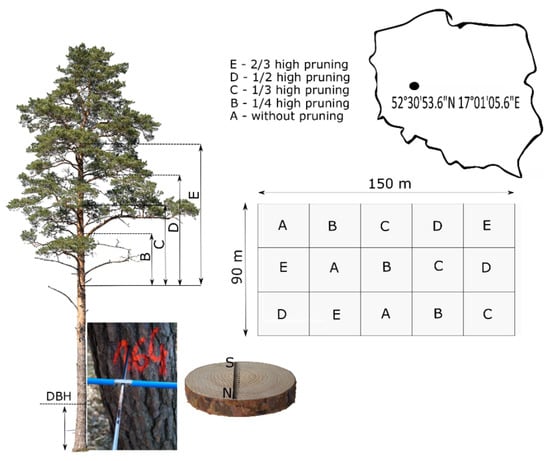
Figure 1.
Location of experimental stand in Poland, five treatments levels (A–E), and location of parcels in the triple-replicated pruning experiment.
In addition, dying trees were removed by thinning. In 2019, in each parcel tree height, the crown length, crown diameter, and diameter at breast height (DBH) of all the trees were measured.
Crown lengths and diameters were measured with a “Nicon Forestry” laser altimeter. Two crown diameters were measured, i.e., the largest and the smallest.
Based on the breast height and height of the measured trees, the parameters of an average tree were calculated (DBH = 35.20 cm; H = 27.50 m). Then, three average trees were selected in each plot allowing a 10% deviation from the model tree parameters. We then extracted tree cores from each selected tree using an increment auger. Trees for the study were selected so that the cross-section of each tree was similar to that of a circle. It was assumed that the difference between the diameters (DBH) in the N–S and W–E directions would be at most 0.5 cm. The wood cores were collected at breast height, 1.3 m above ground, from two cardinal directions, i.e., north and south. The cores were sanded and prepared, and then the width of the ring, earlywood, and latewood were measured at a 0.1 mm precision using a tree ring measuring table. We calculated average ring width, earlywood, and latewood for the period preceding pruning (about 10 years).
The study of the wood grain was conducted following the standard requirements: PN-D-94021:2013 (ISC 79.040) was used using Brinell′s increment borer. The study was conducted on the cross-section of the samples taken from the middle part of the studied elements. For greater measurement precision, the analysed measured length was referred to as the entire cross-section.
The average wood grain “S” was calculated with an accuracy of 0.1 mm on the basis of the dependency:
where S—mean width of annual increment [mm], N—number of annual rings in the length of the sampling line (measuring section) [pcs], and L—length of the sampling line (measuring section) [mm].
S = L/N [mm]
We then used the cores to quantify the wood density using methods of Ericson (1959) modified by Wąsik (2012) and Wąsik et al. (2015). Our method ensured the derived wood density was representative of the cross-section of the trunk. Each of the studied cores was divided into three sections (0 = 1–15 years before pruning, and I = 16–25 years and II = 26–35 years after pruning) and dried in a kiln oven at an air temperature of 105 °C. The core sections were weighed every six hours until the mass was constant. Drying lasted 24 h (dried until no weight loss was observed in the samples). Then, the core sections were weighed on laboratory scales with a 0.001 g accuracy. We used the water displacement method to determine the sample volume as per reference [29] after reference [30]. The samples were placed in test tubes with distilled water to the point of spontaneous sinking (maximum swelling) in order to measure the volume using the hydrostatic method (water displacement).
Based on the obtained data, the density was calculated using the following formula:
where m0—mass of the sample in an absolutely dry state and Vmax—the volume of the sample in the maximal saturation state.
Qu = m0/Vmax, [kg/m3]
We used descriptive statistics for the analysis and presenting the results, such as arithmetic mean, minimum and maximum values, standard deviation, and variation coefficients. Normal distribution was checked using the Shapiro–Wilk tests. Since the studied variables were normally distributed, we used the ANOVA test of significance to check the effects of the pruning treatment. For the analysis of differences between the features, we used post hoc tests. All statistical analysis and preparation of images were conducted using the Statistica 13.1 software.
3. Results
3.1. Comparable Starting Conditions for Pruned Trees
The ring width and earlywood and latewood thickness of the studied pines did not significantly vary before the pruning was conducted, that is, up to the age of 15 years before 1951 (Table 2). Our results showed that the mean ring width varied between 2.51 mm in pruning variants A (unpruned) and D and 2.55 mm in variants B and C. There were no significant differences in the ring width between the parcels before pruning commenced at p ≤ 0.05. The mean earlywood width ranged between 1.38 mm in variants B and E and 1.43 mm in variant D, and the latewood width ranged between 1.15 mm in variant E and 1.18 mm in variant C (Table 2). The differences in the mean widths of annual rings and their zones (early and late wood) and between the comparative pruning variants were not statistically significant (p ≤ 0.05).

Table 2.
Summary of tree increment of analysed Scots pines (Pinus sylvestris L.) by pruning variant before pruning treatment started (before stand age of 15 years). X is arithmetic mean; Sd is standard deviation. CV is coefficient of variation (X/Sd) in percent (There were a total of nine observations in each pruning variant—three for each parcel).
3.2. Effect of Pruning on Ring Width, Earlywood, and Latewood over Seven Decades
We next used the analysis of variance of the annual ring width, earlywood, and latewood for the 68 years after pruning to determine the influence of pruning on tree growth. Variant B (removing 25% of the live crown) had the highest mean ring width of 2.12 mm (Table 3, Figure 2), while the unpruned treatment (A) had the lowest mean ring width of 1.93 mm, and this difference was statistically significant (p ≤ 0.05). The widest zone of earlywood (1.11 mm) was also observed in variant B. The value was significantly higher (p ≤ 0.05) than in the other variants (A, C, D, and E). The widest latewood, on the other hand, was observed in the two more intense pruning variants, D and E (removing 50% and 67% of live crown). The values were statistically significantly higher (p ≤ 0.05) than in the other pruning variants (Table 3, Figure 2). The narrowest latewood was found in the unpruned pines (A) with a mean latewood of 0.94 mm.

Table 3.
Summary of tree increment of analysed Scots pines (Pinus sylvestris L.) by pruning variant at a stand age of 83 years (68 years after pruning). For details see Table 2.

Figure 2.
Mean widths of the annual ring of earlywood and latewood depending on the pruning variant (68 years after the procedure).
3.3. Permanence of Pruning Effect over Time
We were next interested in whether the effect of pruning changed over time, separating our results into three regions of the wood cores (0 = 1–15 years before pruning) and in the two decades after pruning (I = 16–25 years and II =26–35 years after pruning).
The width of the earlywood of the unpruned pines (A) gradually decreased from 1.35 mm to 1.05 mm (Figure 3) two decades after the procedure. In the case of the pruned trees, up to 1/4 of the living crown (B) of the earlywood had a similar width before the procedure, and in the following two decades after pruning it was between 1.38 mm to 1.45 mm. In the other pruning variants (C, D, and E) in the I decade after pruning, a sharp decrease in earlywood in the annual ring was observed. The greatest change was observed in variant E, where the mean width of the earlywood in the annual ring dropped from 1.38mm in the time before pruning to 0.91 mm in the II decade after pruning.
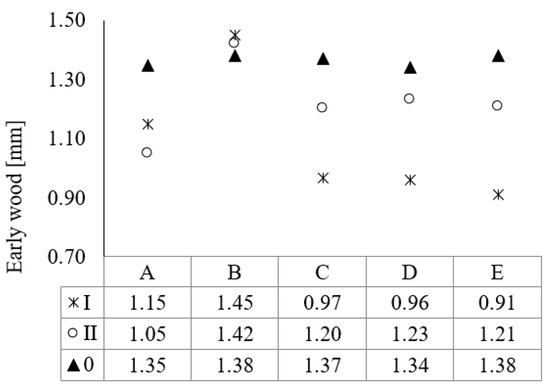
Figure 3.
Increment variability on the thickness of earlywood depending on the pruning variant and the amount of time since the procedure (0 = up to 15 years, I = 16–25 years, and II = 26–35 years).
Latewood mainly fulfills mechanical functions in coniferous trees. In the case of the unpruned trees, there was a decrease in the latewood in the two following decades. The decrease in width was from 1.16 mm to 0.88 in the I decade and to 0.95 mm in the II decade after the procedure, and these results were statistically significant (p ≤ 0.05). In the case of other variants, there was also a decline in the latewood after pruning. In the variants B, C, and D in the I decade, the decrease was noticeably greater than in the II decade (Figure 4). However, in variant E, where the trees were pruned up to the 2/3 of the living crown, no statistically significant differences between the compared periods were observed. In this variant, the width of the latewood was between 1.09 mm in the I decade after pruning and 1.15 mm in the period before pruning (up to the age of 15). The reaction to pruning, indicated as the change in the width of the entire annual ring, is depicted in Figure 5. In the case of the control trees (A), the mean width of the annual rings in the two following decades after pruning decreased significantly from 2.51 mm in the period before pruning (0) to 2.03 mm in the I decade and 2.00 mm in II decade. The decrease in the width of the annual ring was statistically significantly lower (p ≤ 0.05) in the following decades (I and II) than in the period before pruning (0). The pruning variant B (pruning up to 1/4 of the living crown) did not indicate any statistically significant changes in the width of the annual ring. Its width in this variant was between 2.51 mm and 2.56 mm and was not statistically significantly different. Significant differences in the mean width of the annual rings occurred in the other three variants (C, D, and E). In the I decade after pruning, the mean width of the annual rings lowered significantly and was 1.96 mm in variant C, 1.95 mm in variant D, and 2.00 mm in variant E, where during the control period, (before pruning, 0) the mean widths in the variants were 2.55 mm, 2.51 mm, and 2.53 mm, respectively (Figure 5). In the next decade (II), there was an increase in the mean width of the annual ring in variants E, D, and C to the levels of 2.29 mm, 2.31 mm and 2.34 mm, respectively, and these results were statistically insignificant during the control period before pruning (0).
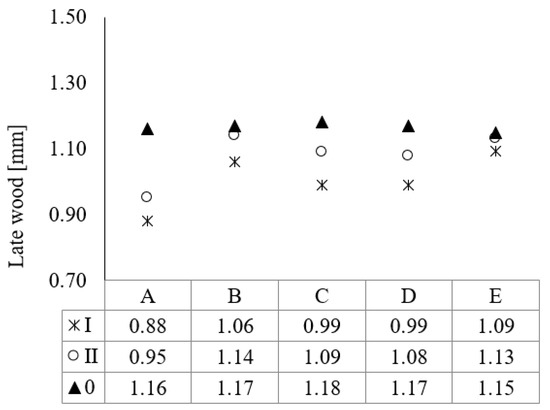
Figure 4.
Increment variability on the thickness of latewood depending on the pruning variant and the amount of time since the procedure (0 = up to 15 years, I = 16–25 years, II = 26–35 years).
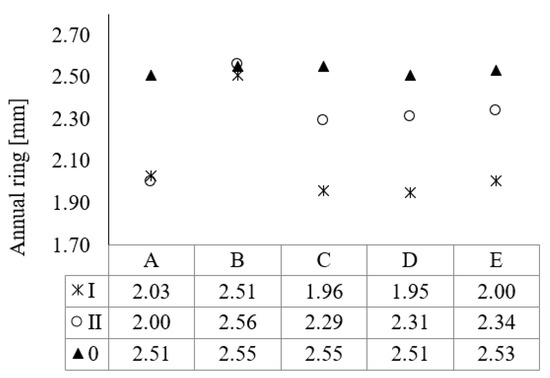
Figure 5.
Increment variability on the width of annual ring depending on the pruning variant and the amount of time since the procedure (0 = up to 15 years, I = 16–25 years, II = 26–35 years).
It was assumed that there would be a relationship between pruning, the increment variability in earlywood and latewood, and the density of the wood tissue. The existence of significantly differences in the wood tissue density in the compared pruning variants was ascertained.
3.4. Wood Density Is Changed by Pruning
The lowest values, 615 kg/m3, were observed in the case of the unpruned pine wood (A). The value was statistically lower (p ≤ 0.05) in comparison to the wood density in the variants (aC, aD, and aE). In the case of the pruned pines in variants D and E, the highest values of wood density were 679 kg/m3 and 671 kg/m3, respectively. They were statistically significantly higher than the density in variants bA and bB. In variant B and C, the mean wood densities were comparable and were 641 kg/m3 and 654 kg/m3, respectively, while the wood density in variant B was statistically significantly lower than that in variants D and E (Figure 6). It was also important to discuss the standard deviation of the mean wood density. The greatest standard deviation was observed in variants A and E (12.5 kg/m3 and 10.5 kg/m3), which indicated a great variability in the wood tissue density in these variants. Moreover, an analysis of variability of the wood tissue density in the period before pruning (0) and in the two following decades (I and II) was conducted. In the period before pruning (0), the mean wood tissue density was between 603 kg/m3 in variant A and 614 kg/m3 in variant B. The differences between the variants in the period before pruning were not statistically significant. Variant A (unpruned) characterised itself with a lack of any clear differentiation concerning the wood tissue density, and in the following decades (I and II) it increased to 605 kg/m3, which was not statistically significant. In the decades (I and II) after pruning, there was a clear differentiation between the particular variants as far as wood density is concerned. The increase in the mean wood density in variant E was the most noticeable. The density in this variant in the I decade after pruning increased to 660 kg/m3, but in the II decade there was a slight fall to 655 kg/m3, which was unusual in comparison to the other variants (Figure 7). In variant B, after pruning there was a clear, statistically significant increase in the mean wood density from 642 kg/m3 to 644 kg/m3 in the second decade (II). There were no statistically significant differences in the wood density between the I and II decades after pruning. The differences occurred in variants C and D, in which the gradual increase in the wood tissue density in the following decade after pruning was observed (Figure 7). The standard deviation of the wood density up to the pruning treatment was similar, ranging from 19.3 to 23.5 kg/m3. The highest standard deviation of the wood density occurred in the E pruning variant in the second decade after pruning was observed.
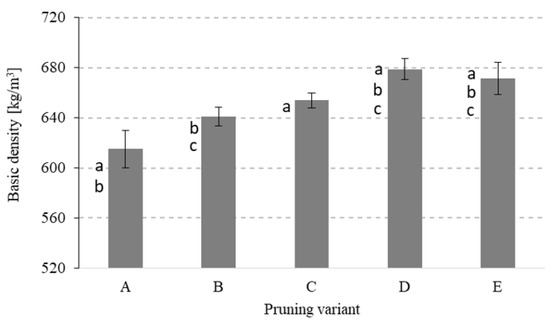
Figure 6.
Mean wood density of the pine depending on the pruning variant. a, b, and c indicate statistically significant differences at the level of p ≤ 0.05.
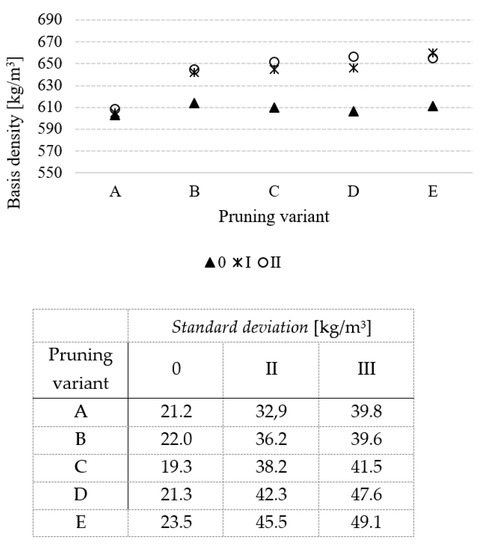
Figure 7.
Mean wood density of pine depending on the pruning variant and the amount of time since the procedure (0 = up to 15 years, I = 16–25 years, II = 26–35 years).
4. Discussion
The literature that describes the impact of various factors on the qualitative and quantitative shaping of wood features is extensive. The external factors’ influences on the growth and development of trees and tree stands have been demonstrated in many reports [2,31,32,33], and some researchers [34,35] have discussed their influences on wood properties. The most crucial external factors influencing the formation of the qualitative and quantitative differences between individuals are climate, forest habitat type, the biosocial position of the tree in the stand, and forest management [34,35,36,37].
There is also extensive literature describing the density of pine wood [38,39,40]. In Poland, depending on the tending operations, growth conditions, or genetic characteristics, the density of pinewood varies from about 420 kg/m3 to even nearly 700 kg/m3 [41,42].
It is rare or unusual for study results on the influence of tree pruning in commercial forests on tree and tree stand functions and wood tissue formation to be found in the current literature. The accessible results usually concern modeling the pine stand’s structure, which includes pruning [43] or even adopting models to determine the optimal number of pruned trees or the intensity of the procedure [27]. Some studies concerning the influence of pruning on the size and number of knots in sawn lumber [44] and the formation of heartwood and sapwood [15,28] are available. In this experiment, the focus was primarily on pruning conducted with various intensities and its impact on the thickness increment in the structure and wood tissue density.
According to Uotila et al. [27], the removal of 40% or more of the living crown results in a significant decrease in the growth and thickness increment. Uotila et al. observed that pruning up to 40% of the living crown causes the decrease in the thickness increment to 33%, but this also resulted in a higher production of knotless wood.
However, according to the results obtained by Smith [31], thinning and pruning 4 years after the procedure in Pinus taeda significantly impacted radial growth as well as the increase in wood density and the increase in the percentage of latewood in the annual ring. According to the author, a change in the relationship between the specific gravity and the percentage of latewood indicated the fundamental changes in the wood structure associated with thinning and pruning. The results of this experiment clearly corroborated the finding that pruning influences wood tissue density. However, pruning did not cause an increase in the radial growth; rather, it caused its decrease.
The results indicated the relationship between the crown dimension and the size of the earlywood areas that are responsible for transporting water in the trunk. Particularly in the first and second periods after pruning, the width of the vascular areas of the annual ring dropped sharply in the variants where the living crown was reduced by 1/2 and 2/3. The greatest fall in the thickness increment was observed in variants C, D (1/3 and 1/2), and E (2/3); however, this was not statistically significant. The statistically significant element was the decrease in the width of earlywood, which in variants C, D, and E dropped by about 30% in comparison to the period before pruning, while the decrease in comparison to the unpruned trees was only visible in the first decade after pruning (I, 16–25 years). The variability in the width of the annual rings depending on the reduction in the living crown, particularly in the earlywood, which is responsible for the hydraulic conductivity of the trunk, seemed justified and could refer to the theory proposed by [45], which has been verified multiple times and has been extensively described [46,47]. In theory, there is a directly proportional dependency between the root system, vascular area of the trunk (sapwood and earlywood), and the size and efficiency of the assimilation apparatus. It is most probable that the reason for the reduced area transporting water and minerals in the pines, with the exponential decrease in the size of the assimilation apparatus, was to prevent cavitation, which can be a reason for the physiological death of a tree [48].
Interestingly, the reduction in the crown by 1/4 did not significantly change the decrease in the annual ring width in the first (I), rather than the second (II), decade after pruning. However, a slight decrease in the width of the latewood in variants C and D (1/3 and 1/2) was observed. No influence of pruning was noticed in variant E (2/3) regarding the decrease in the mean width of the latewood in the annual ring width, which may be justified by the biomechanical function of the tree.
The pruning process led to a reduction in the assimilation apparatus and to an increase in tree’s centre of gravity, which in the first year after pruning forced a number of adaptive changes in the tree’s tissue structure. At the same time, as the decrease in the annual ring width took place, and there was an increase in the percentage of latewood and in the tree tissue density. These changes probably occurred to ensure the mechanical stability of the tree, which was distorted by the reduced crown and the increased centre of gravity. This was particularly visible in variant E (2/3), i.e., trees with a substantially reduced crown. The results obtained by [49] corroborated the theory that the size, shape, and structure impact the mechanical stability of a tree. As a result, the allocation of the biomass during the tree growth could be limited, which particularly affects photosynthesis and water transportation. If the above limitations are not exceeded, then other limitations concerning the size and the shape imposed by the biomechanical system could occur [50]. However, it is difficult to determine an optimal distribution of the biomass, and this is different for each tree. Comparisons of the hydraulic efficiency of the xylem with its mechanical function are not conducted very often. It is crucial for the assimilation apparatus to have suitable mechanical support and access to water and nutrients [51], as these directly impact photosynthetic productivity. The mechanism, which is based on adaptive plant growth, has been already recognised, examined, and partly described [50,52,53,54,55].
Apart from the intended commercial/economic procedures such as pruning, there are other factors such as genetic variability and environmental conditioning that overlap and permeate, which is known as adaptive tree growth [43,56]. Thus, pruning can have an important impact on the relationship between the features of tree tissue and the morphological structure of trees. The tree crown plays a key role here as it determines the xylem properties, since this supplies the products of photosynthesis and controls wood production through hormones [43,57,58]. This is why pruning of the living crown shapes the wood tissue in many stages of its formation. As a result, the results indicated that the xylem is optimised in terms of its served functions, the conditions of tree growth, and the strategies facilitating its survival [51].
The described results are only a conceptual framework, which can be used to establish the relationship between the intensity of pruning, the cost, and the desired increase in wood quality that is defined not only by the number of knots but also by the changes in the wood tissue density or by the annual ring width of particular zones. This study can also help to popularize and extend the knowledge connected with biomechanical functioning, which results from the crown reduction and the changed centre of gravity of a tree.
5. Conclusions
The role of pruning is to improve the quality of timber by reducing the number of open knots and increasing the knot-free area in the butt of the trunk. In the controlled experiment, the impact of various pruning models of Scots pine (Pinus silvestris L.) on the features of the wood tissue over the scope of 68 years after the initial pruning was examined. It was stated that there is a crucial impact of pruning and its degree on the formation of the annual ring’s width and the tree tissue density. After the procedure, there was a significant decrease in the mean width of the annual ring, with the exception of variant B, and in all other variants there was a significant increase in the wood density, with the exception of variant A, which was a reference sample.
Due to the tree tissue quality, the reduction of the crown by 1/2 was the optimal model as it revealed a compromise between the quality and proper functioning of the tree. In this model, there was a significant density increment of the tree tissue with the mean width of the annual ring, which was slightly above 2 mm, which is considered optimal for the technical wood properties in pine.
The conducted study proved that pruning significantly influences the functioning of trees both as far as mechanical as well physiological functions are concerned, which translated into the qualitative and quantitative formation of tree tissue.
Author Contributions
Conceptualization, T.J., A.T. and W.P.; Methodology, T.J., A.T. and W.P.; Validation, T.J. and M.N.; Formal Analysis, T.J., A.T., J.K., R.K. and T.S.; Data Curation, W.G., J.K., K.K. and B.N.; Writing—Original Draft Preparation, T.J.; Writing—Review & Editing, T.J. and M.N.; Supervision, T.J.; Project Administration, J.K.; Funding Acquisition, T.J. All authors have read and agreed to the published version of the manuscript.
Funding
The publication was financed within the framework of a subsidy for science granted by the Minister of Science and Higher Education—data acquisition, laboratory work. The publication was co-financed within the framework of the Polish Ministry of Science and Higher Education’s program “Regional Initiative Excellence” in the years 2019–2023 (No. 005/RID/2018/19)”, financing amount 12,000,000 PLN—proofreading, open access fee.
Data Availability Statement
The study did not report any data.
Conflicts of Interest
The authors declare no conflict of interest.
Appendix A
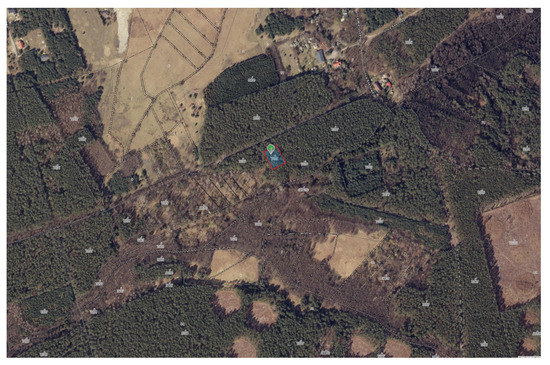
Figure A1.
Location of the experimental stand in Poland in 2019.
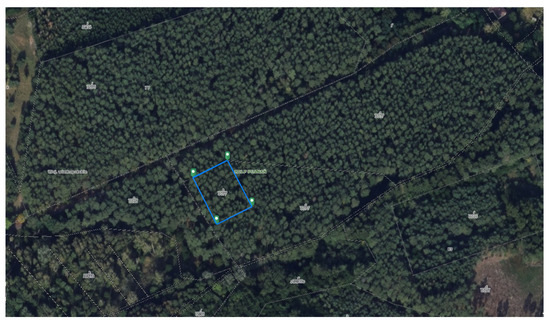
Figure A2.
Location of the experimental stand in Poland in 2019.
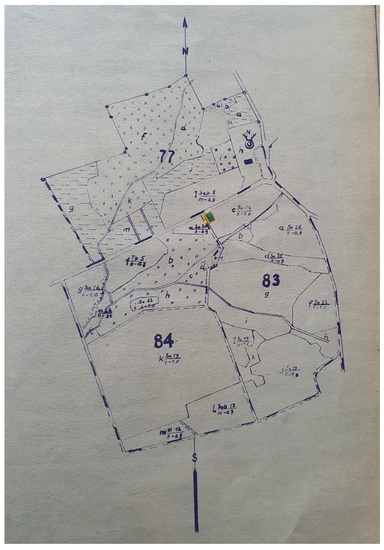
Figure A3.
Map of the plot in 1951 (historical data).

Table A1.
Dimensions of sample trees at the age of 35 years (historical data).
Table A1.
Dimensions of sample trees at the age of 35 years (historical data).
| Dimensions of Sample Trees at the Age of 35 Years | |||||||||
|---|---|---|---|---|---|---|---|---|---|
| Tree I | Tree II | Tree III | Tree IV | ||||||
| Pruning Variant | DBH with Bark [cm] | Height [m] | DBH with Bark [cm] | Height [m] | DBH with Bark [cm] | Height [m] | DBH with Bark [cm] | Height [m] | |
| 0 | A | 11.9 | 16.4 | 14.0 | 17.0 | 16.0 | 18.4 | 19.8 | 19.7 |
| 1/4 | B | 11.5 | 14.8 | 13.4 | 16.5 | 15.6 | 17.4 | 20.4 | 18.4 |
| 1/3 | C | 10.9 | 15.2 | 13.1 | 18.4 | 15.3 | 18.6 | 18.5 | 18.0 |
| 1/2 | D | 10.7 | 14.6 | 12.5 | 16.4 | 15.3 | 17.6 | 18.5 | 18.2 |
| 2/3 | E | 10.7 | 14.7 | 12.1 | 16.5 | 15.4 | 18.0 | 18.4 | 18.0 |

Table A2.
Height and diameter increment.
Table A2.
Height and diameter increment.
| Height Increment Per Tree [cm] | Diameter Increment [m2] | Number of Trees | |||||
|---|---|---|---|---|---|---|---|
| Pruning Variant | 1951 | 1952 | 1951 | 1952 | 1951 | 1975 | |
| 0 | A | 30.0 | 34.0 | 1.6 | 2.8 | 860 | 516 |
| 1/4 | B | 25.0 | 28.0 | 1.6 | 2.5 | 980 | 529 |
| 1/3 | C | 30.0 | 32.0 | 1.5 | 2.8 | 872 | 453 |
| 1/2 | D | 24.0 | 25.0 | 1.4 | 2.3 | 900 | 495 |
| 2/3 | E | 23.0 | 24.0 | 1.4 | 1.9 | 872 | 427 |

Table A3.
Meteorological data (research area).
Table A3.
Meteorological data (research area).
| Meteorolog-ical Data | Year | Month | |||||||||||
|---|---|---|---|---|---|---|---|---|---|---|---|---|---|
| I | II | III | IV | V | VI | VII | VIII | IX | X | XI | XII | ||
| Precipitation [mm] | 1951 | 31.4 | 37.7 | 23.8 | 27.4 | 32.0 | 52.0 | 52.5 | 78.9 | 12.9 | 0.2 | 39.6 | 10.6 |
| 1952 | 40.1 | 22.5 | 19.5 | 25.6 | 63.3 | 63.3 | 32.6 | 40.5 | 66.5 | 35.4 | 26.9 | 8.5 | |
| Temperature [°C] | 1951 | −0.4 | 0.8 | 1.1 | 8.7 | 12.0 | 17.8 | 18.3 | 19.4 | 15.0 | 6.9 | 6.9 | 3.0 |
| 1952 | 0.7 | 0.2 | −0.8 | 10.7 | 12.0 | 15.8 | 18.2 | 18.8 | 11.7 | 7.0 | 5.5 | 2.7 | |
| Relative humidity [%] | 1951 | 82 | 86 | 78 | 61 | 69 | 65 | 71 | 73 | 75 | 76 | 88 | 82 |
| 1952 | 85 | 87 | 70 | 72 | 72 | 73 | 67 | 74 | 81 | 89 | 89 | 81 | |
References
- Prescher, F.; Stahl, E.G. The Effect of Provenance and Spacing on Stem Straightness and Number of Spike Knots of Scots Pine in South and Central Sweden; Faculty of Forestry, Swedish University of Agricultural Sciences: Uppsala, Switzerland, 1986. [Google Scholar]
- Savidge, R.A.; Jeronimidis, G. Tree Growth and Wood Quality. In Wood Quality and Its Biological Basis; Barnett, J.R., Jeronimidis, G., Eds.; Blackwell Publishing: Oxford, UK, 2003; pp. 1–29. [Google Scholar]
- Brüchert, F.; Becker, G.; Speck, T. The mechanics of Norway Spruce [Picea abies (L.) Karst]: Mechanical Properties of Standing Trees from Different Thinning Regimes. For. Ecol. Manag. 2000, 135, 45–62. [Google Scholar] [CrossRef]
- Tomczak, A.; Pazdrowski, W.; Jelonek, T. Quality of Scots pine (Pinus sylvestris L.) wood. Part III. The effect of silviculture on wood quality. Sylwan 2009, 153, 519–527. [Google Scholar]
- Mäkinen, H. Growth, Suppression, Death, and Self-Pruning of Branches of Scots Pine in Southern and Central Finland. Can. J. For. Res. 1999, 29, 585–594. [Google Scholar] [CrossRef]
- Mäkinen, H.; Colin, F. Predicting the Number, Death, and Self-Pruning of Branches in Scots Pine. Can. J. For. Res. 1999, 29, 1225–1236. [Google Scholar] [CrossRef]
- Jelonek, T.; Pazdrowski, W.; Tomczak, A. Biometric Traits of Wood and Quality of Timber Produced in Former Farmland. Balt. For. 2008, 14, 138–148. [Google Scholar]
- Sellier, D.; Fourcaud, T. Crown Structure and Wood Properties: Influence on Tree Sway and Response to High Winds. Am. J. Bot. 2009, 96, 885–896. [Google Scholar] [CrossRef]
- Krajnc, L.; Farrelly, N.; Harte, A.M. The Influence of Crown and Stem Characteristics on Timber Quality in Softwoods. For. Ecol. Manag. 2019, 435, 8–17. [Google Scholar] [CrossRef]
- Gajewska, J.; Azzahra, N.A.; Bingöl, Ö.A.; Jankowska, K.I.; Jelonek, T.; Deckert, J.; Wieczorek, J.F.; Jelonek, M.A. Cadmium Stress Reprograms Ros/Rns Homeostasis in Phytophthora infestans (Mont.) de bary. Int. J. Mol. Sci. 2020, 21, 8375. [Google Scholar] [CrossRef]
- Fernández Quiroga, M.P.; Basauri, J.; Madariaga, C.; Miguélez, M.M.; Olea, R.; Gerendiain, A.Z. Effects of Thinning and Pruning on Stem and Crown Characteristics of Radiata Pine (Pinus radiata D. Don). IForest 2017, 10, 383–390. [Google Scholar] [CrossRef]
- Alcorn, P.J.; Bauhus, J.; Smith, R.G.B.; Thomas, D.; James, R.; Nicotra, A. Growth Response Following Green Crown Pruning in Plantation-Grown Eucalyptus pilularis and Eucalyptus cloeziana. Can. J. For. Res. 2008, 38, 770–781. [Google Scholar] [CrossRef]
- Amateis, R.L.; Burkhart, H.E. Growth of Young Loblolly Pine Trees Following Pruning. For. Ecol. Manag. 2011, 262, 2338–2343. [Google Scholar] [CrossRef]
- Víquez, E.; Víquez, D. Effect of Pruning on Tree Growth, Yield, and Wood Properties of Tectona grandis Plantations in Costa Rica. Silva Fenn. 2005, 39, 381. [Google Scholar] [CrossRef]
- Långström, B.; Hellqvist, C. Effects of Different Pruning Regimes on Growth and Sapwood Area of Scots Pine. For. Ecol. Manag. 1991, 44, 239–254. [Google Scholar] [CrossRef]
- Gyenge, J.; Fernández, M.; Schlichter, T. Effect of Stand Density and Pruning on Growth of Ponderosa Pines in NW Patagonia, Argentina. Agrofor. Syst. 2010, 78, 233–241. [Google Scholar] [CrossRef]
- Cown, D. Effects of Severe Thinning and Pruning Treatments on the Intrinsic Wood Properties of Young Radiata Pine. N. Z. J. For. Sci. 1973, 3, 379–389. [Google Scholar]
- Burkhart, H.E.; Amateis, R.L. Effects of Early Pruning on Ring Specific Gravity in Young Loblolly Pine Trees. Wood Fiber Sci. 2020, 52, 139–151. [Google Scholar] [CrossRef]
- Gartner, B.L.; Robbins, J.M.; Newton, M. Effects of Pruning on Wood Density and Tracheid Length in Young Douglas-Fir. Wood Fiber Sci. 2005, 37, 304–313. [Google Scholar]
- Moreno-Fernández, D.; Hevia, A.; Majada, J.; Cañellas, I. Do Common Silvicultural Treatments Affect Wood Density of Mediterranean Montane Pines? Forests 2018, 9, 80. [Google Scholar] [CrossRef]
- Sutton, W.R.J.; Crowe, J.B. Selective Pruning of Radiata Pine. N. Z. J. For Sci. 1975, 5, 171–195. [Google Scholar]
- Hevia, A.; Alvarez-González, J.G.; Majada, J. Effects of Pruning on Knotty Core Taper and Form of Pinus radiata and Pinus pinaster. Eur. J. Wood Wood Prod. 2016, 74, 741–750. [Google Scholar] [CrossRef]
- Neilsen, W.A.; Pinkard, E.A. Effects of Green Pruning on Growth of Pinus radiata. Can. J. For. Res. 2003, 33, 2067–2073. [Google Scholar] [CrossRef]
- Oleksyn, J.; Reich, P.; Chalupka, W.; Tjoelker, M. Differential Above and Below-ground Biomass Accumulation of European Pinus sylvestris Populations in a 12-year-old Provenance Experiment. Scand. J. For. Res. 1999, 14, 7–17. [Google Scholar] [CrossRef]
- Kurbanov, E.; Vorobyov, O.; Gubayev, A.; Moshkina, L.; Lezhnin, S. Carbon Sequestration After Pine Afforestation on Marginal Lands in the Povolgie Region of Russia: A Case Study of the Potential for a Joint Implementation Activity. Scand. J. For. Res. 2007, 22, 488–499. [Google Scholar] [CrossRef]
- Li., M.-Y.; Leng, Q.-N. Li. M.-Y.; Leng, Q.-N.; Hao, G-Y. Contrasting patterns of radial growth rate between Larix principis-rupprechtii and Pinus sylvestris var. Mongolica along an elevational gradient are mediated by differences in xylem hydraulics. For. Ecol. Manag. 2021, 497, 119524. [Google Scholar] [CrossRef]
- Uotila, A.; Mustonen, S. The Effect of Different Levels of Green Pruning on the Diameter Growth of Pinus sylvestris L. Scand. J. For. Res. 1994, 9, 226–232. [Google Scholar] [CrossRef]
- Bergström, B.; Gref, R.; Ericsson, A. Effects of Pruning on Heartwood Formation in Scots Pine Trees. J For. Sci. 2004, 50, 11–16. [Google Scholar] [CrossRef]
- Wąsik, R.; Michalec, K.; Barszcz, A. The Variability of Certain Macrostructural Features and the Density of Grand Fir (Abies grandis Lindl.) Wood from Selected Stands in Southern Poland. Drewno 2015, 8, 45–58. [Google Scholar] [CrossRef]
- Olesen, P.O. The Water Displacement Method: A Fast and Accurate Method of Determining the Green Volume of Wood Samples. For. Tree Improv. 1971, 1971, 3–23. [Google Scholar]
- Smith, D.M. Wood Quality of Loblolly Pine after Thinning; Forest Products Lab Madison: Madison, WI, USA, 1968. [Google Scholar]
- Winandy, J.E. Wood Properties. Encycl. Agric. Sci. 1994, 4, 549–561. [Google Scholar]
- Schweingruber, F.H. Wood Structure and Environment; Springer Science & Business Media: Berlin/Heidelberg, Germany, 2007. [Google Scholar]
- Persson, B.; Persson, A.; Ståhl, E.G.; Karlmats, U. Wood Quality of Pinus sylvestris Progenies at Various Spacings. For. Ecol. Manag. 1995, 76, 127–138. [Google Scholar] [CrossRef]
- Jelonek, T.; Pazdrowski, W.; Tomczak, A. The Efect of Biological Class and Age on Physical and Mechanical Properties of European Larch (Larix decidua mill.) in Poland. Wood Res. 2009, 54, 1–14. [Google Scholar]
- Wiemann, M.C.; Williamson, G.B. Geographic Variation in Wood Specific Gravity: Effects of Latitude, Temperature, and Precipitation. Wood Fiber Sci 2002, 34, 96–107. [Google Scholar]
- Mäkinen, H.; Isomäki, A. Thinning Intensity and Growth of Scots Pine Stands in Finland. For. Ecol. Manag. 2004, 201, 311–325. [Google Scholar] [CrossRef]
- Repola, J. Models for Vertical Wood Density of Scots Pine, Norway Spruce and Birch Stems, and their Application to Determine Average Wood Density. Silva Fenn. 2006, 40, 673–685. [Google Scholar] [CrossRef]
- Auty, D.; Achim, A.; Macdonald, E.; Cameron, A.D.; Gardiner, B.A. Models for Predicting Wood Density Variation in Scots Pine. Forestry 2014, 87, 449–458. [Google Scholar] [CrossRef]
- Zeller, L.; Ammer, C.; Annighöfer, P.; Biber, P.; Marshall, J.; Schütze, G.; del Río Gaztelurrutia, M.; Pretzsch, H. Tree Ring Wood Density of Scots Pine and European Beech Lower in Mixed-Species Stands Compared with Monocultures. For. Ecol. Manag. 2017, 400, 363–374. [Google Scholar] [CrossRef]
- Jelonek, T. Wood density of Scots pine (Pinus sylvestris L.) in Poland. Ann. Wars. Univ. Life Sci. -SGGW. For. Wood Technol. 2008, 65, 157–163. [Google Scholar]
- Kozakiewicz, P.; Jankowska, A.; Mamiński, M.; Marciszewska, K.; Ciurzycki, W.; Tulik, M. The Wood of Scots Pine (Pinus sylvestris L.) from Post-Agricultural Lands Has Suitable Properties for the Timber Industry. Forests 2020, 11. [Google Scholar] [CrossRef]
- Kellomäki, S.; Ikonen, V.P.; Peltola, H.; Kolström, T. Modelling the Structural Growth of Scots Pine with Implications for Wood Quality. Ecol. Model. 1999, 122, 117–134. [Google Scholar] [CrossRef]
- Ikonen, V.P.; Kellomäki, S.; Peltola, H. Sawn Timber Properties of Scots Pine as Affected by Initial Stand Density, Thinning and Pruning: A Simulation Based Approach. Silva Fenn. 2009, 43, 411–431. [Google Scholar] [CrossRef]
- Shinozaki, K.; Yoda, K.; Hozumi, K.; Kira, T. A Quantitative Analysis of Plant Form; The Pipe Model Theory, I. Basic Analyses. Jpn. J. Ecol. 1964, 14, 97–105. [Google Scholar] [CrossRef]
- Jelonek, T.; Pazdrowski, W.; Arasimowicz, M.; Tomczak, A.; Walkowiak, R.; Szaban, J. The Applicability of The Pipe Model Theory in Trees of Scots Pine of Poland. J. For. Sci. 2008, 54, 519–531. [Google Scholar] [CrossRef]
- Lehnebach, R.; Beyer, R.; Letort, V.; Heuret, P. The Pipe Model Theory Half a Century on: A Review. Ann. Bot. 2018, 121, 773–795. [Google Scholar] [CrossRef] [PubMed]
- Cochard, H. Nucleation/Nucléation Cavitation in Trees. C. R. Phys. 2006, 7, 1018–1026. [Google Scholar] [CrossRef]
- James, K.R.; Haritos, N.; Ades, P.K. Mechanical Stability of Trees under Dynamic Loads. Am. J. Bot. 2006, 93, 1522–1530. [Google Scholar] [CrossRef]
- Spatz, H.C.; Bruechert, F. Basic Biomechanics of Self-Supporting Plants: Wind Loads and Gravitational Loads on a Norway Spruce Tree. For. Ecol. Manag. 2000, 1–3, 33–44. [Google Scholar] [CrossRef]
- Mencuccini, M.; Grace, J.; Fioravanti, M. Biomechanical and Hydraulic Determinants of Tree Structure in Scots Pine: Anatomical Characteristics. Tree Physiol. 1997, 17, 105–113. [Google Scholar] [CrossRef]
- Hinrichsen, D. The Forest Decline Enigma: What Underlies Extensive Dieback on Two Continents? Bioscience 1987, 37, 542–546. [Google Scholar] [CrossRef]
- Mattheck, G.C. Mechanical Classification of Adaptive Growth. In Trees; Springer: Berlin/Heidelberg, Germany, 1991; pp. 16–20. [Google Scholar]
- Geritz, S.A.H.; Kisdi, É.; Meszéna, G.; Metz, J.A.J. Evolutionarily Singular Strategies and the Adaptive Growth and Branching of the Evolutionary Tree. Evol. Ecol. 1998, 12, 35–57. [Google Scholar] [CrossRef]
- Brüchert, F.; Gardiner, B. The Effect of Wind Exposure on the Tree Aerial Architecture and Biomechanics of Sitka Spruce (Picea sitchensis, Pinaceae). Am. J. Bot. 2006, 93, 1512–1521. [Google Scholar] [CrossRef]
- Jelonek, T.; Tomczak, A.; Katrusiak, A.; Arasimowicz-Jelonek, M.; Gzyl, J.; Remlein, A. The Novel Relationship Between the Morphological Characteristics of Trees and Ultrastructure of Wood Tissue in Scots Pine (Pinus sylvestris L.). Wood Res. 2015, 60, 519–530. [Google Scholar]
- Savidge, R.A. Xylogenesis, Genetic and Environmental Regulation—A Review. IAWA J. 1996, 17, 269–310. [Google Scholar] [CrossRef]
- Larson, P.R.; Kretschmann, D.E.; Clark, A.I.; Isebrands, J.G. Formation and Properties of Juvenile Wood in Southern Pines: A Synopsis; US Department of Agriculture, Forest Service, Forest Products Laboratory: Madison, WI, USA, 2001; Volume 1. [Google Scholar]
Publisher’s Note: MDPI stays neutral with regard to jurisdictional claims in published maps and institutional affiliations. |
© 2022 by the authors. Licensee MDPI, Basel, Switzerland. This article is an open access article distributed under the terms and conditions of the Creative Commons Attribution (CC BY) license (https://creativecommons.org/licenses/by/4.0/).